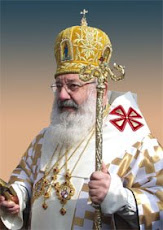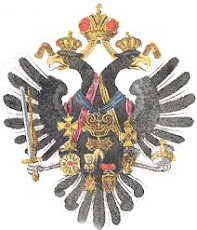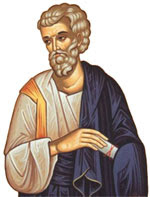In the Maronite and Byzantine churches
St. Sozen
This holy Martyr was a shepherd in Lycaonia. Born a pagan, named Tarasius, he received holy Baptism and was renamed Sozon. Filled with zeal for the truth, he taught his countrymen to desist from the worship of idols. Once he entered the temple of Artemis in Pompeiopolis of Cilicia, cut off the golden hand of the idol, and breaking it in pieces, distributed it among the poor. When he saw that many were being unjustly punished for the theft, of his own accord he gave himself up to Maximian the Governor. He was beaten with rods until his bones were broken. According to some, he suffered martyrdom in 288; according to others, in 304.
In the Roman church
St. Cloud
On the death of Clovis, King of the Franks, in the year 511 his kingdom was divided between his four sons, of whom the second was Clodomir. Thirteen years later he was killed fighting against his cousin, Gondomar, leaving three sons to share his dominions. The youngest of these sons of Clodomir was St. Clodoald, a name more familiar to English people under its French form of Cloud from the town of Saint-Cloud near Versailles. When Cloud was eight years old, his uncle Childebert plotted with his brother, to get rid of the boys and divide their kingdom. The eldest boy, Theodoald was stabbed to death. The second, Gunther fled in terror, but was caught and also killed. Cloud escaped and was taken for safety into Provence or elsewhere.
Childebert and his brother Clotaire shared the fruits of their crime, and Cloud made no attempt to recover his kingdom when he came of age. He put himself under the discipline of St. Severinus, a recluse who lived near Paris, and he afterwards went to Nogent on the Seine and had his heritage where is now Saint-Cloud. St. Cloud was indefatigable in instructing the people of the neighboring country, and ended his days at Nogent about the year 560 when he was some thirty-six years old. St. Cloud's feast day is September 7th.
skip to main |
skip to sidebar
"It is true that we have been latinized. And this is the great merit of Metropolitan Sheptytsky at the beginning of the 20th century: that he tried to reverse this process. Personally, I consider myself a follower of Metropolitan Sheptytsky, together with many others who would like to get rid of all that has illegally entered into our spiritual, theological, liturgical, canonical heritage. We were told: If you want to be a real Catholic, you have to be Latin. And they pushed us into it. And it is only with Metropolitan Sheptytsky that we could say: Dear brothers from Rome, one can be Catholic without being Latin. And we were attacked on two fronts, Catholic-Latin and Orthodox-Byzantine. And we said: No, dear brothers, one can be Ukrainian, one can be Byzantine, one can be at the same time Catholic. These different elements do not contradict one another. So this is why neither the Latin Church nor the Orthodox Church is very happy with us. "- His Beatitude Lubomyr Husar, Patriarch of Kviv-Halych
"In other words, Rome must not require more from the East with respect to the doctrine of primacy than had been formulated and was lived in the first millennium." - former Cardinal Ratzinger









One of my principle patrons
"We no longer knew whether we were in heaven or on earth, nor such beauty, and we know not how to tell of it."
Zoghby Initiative
- I believe everything which Eastern Orthodoxy teaches.
- I am in communion with the Bishop of Rome as the first among the bishops, according to the limits recognized by the Holy Fathers of the East during the first millennium, before the separation.
"It is true that we have been latinized. And this is the great merit of Metropolitan Sheptytsky at the beginning of the 20th century: that he tried to reverse this process. Personally, I consider myself a follower of Metropolitan Sheptytsky, together with many others who would like to get rid of all that has illegally entered into our spiritual, theological, liturgical, canonical heritage. We were told: If you want to be a real Catholic, you have to be Latin. And they pushed us into it. And it is only with Metropolitan Sheptytsky that we could say: Dear brothers from Rome, one can be Catholic without being Latin. And we were attacked on two fronts, Catholic-Latin and Orthodox-Byzantine. And we said: No, dear brothers, one can be Ukrainian, one can be Byzantine, one can be at the same time Catholic. These different elements do not contradict one another. So this is why neither the Latin Church nor the Orthodox Church is very happy with us. "- His Beatitude Lubomyr Husar, Patriarch of Kviv-Halych
"In other words, Rome must not require more from the East with respect to the doctrine of primacy than had been formulated and was lived in the first millennium." - former Cardinal Ratzinger
The Blessed Theotokos

It is truly proper to glorify you, who have borne God,the Ever-blessed, Immaculate, and the Mother of our God.More honorable than the Cherubim, and beyond compare more glorious than the Seraphim,who, a virgin, gave birth to God the Word,you, truly the Mother of God, we magnify. Amen
His Holiness Benedict XVI, Patriarch of the Latins, the Universal Hierarch

His Beatitude Lubomyr Husar, MSU, Patriarch of Kiev and Halych and all Rus

His Grace Robert Moskal, Bishop of Parma

His All Holiness Bartholomew I , the Oecumenical Patriarch of Constantinople

His Holiness Kirill, Patriarch of Moscow and All Russia


"Remember, O Lord, our most devout and faithful Emperor , Otto, whom you have set to rule on the earth. Crown him with a weapon of truth, a weapon of good will; let your shadow fall upon his head in the day of war; strengthen his arm, exalt his right-hand, establish his empire; subdue beneath him all barbarous nations that desire to make war; grant him deep and enduring peace; speak good things to his heart for your Church and for all your people; so that by his tranquility we may lead quiet and peaceful lives, in all piety and purity."
Labels
- Altar Serving (1)
- Americanism (1)
- Animals (1)
- Assyrian (2)
- Benedict XVI (1)
- Benedictine (1)
- Bible (1)
- Blog (1)
- Byzantine (8)
- Cantoring (1)
- Catholic (1)
- Chaldeans (1)
- Charbel (1)
- Church Fathers (1)
- churches (1)
- Conversion (1)
- Coptic (2)
- Coptic Catholic (1)
- Divine Liturgy (8)
- Divine Office (1)
- East Syriac (1)
- Eastern Catholic (10)
- Eastern Catholics (1)
- Eastern Orthodox (10)
- Ecumenical Patriarch (1)
- English (1)
- Ephrem the Syrian (2)
- Great Friday (2)
- Greek (3)
- Greek Festival (1)
- Greek Orthodox (1)
- History (1)
- Hobbies (1)
- Holy Cross (1)
- Icons (3)
- Iraq (1)
- Islam (1)
- Jacobites (1)
- Jacobitism (2)
- Kiev (1)
- Kyiv (1)
- Latin Catholicism (1)
- Lebenese Maronite Order (1)
- Liturgy (6)
- Mar Isaac (3)
- Mar Maron (3)
- Mar Thoma christians (1)
- Maronite (5)
- Maronite Monks of Adoration (1)
- Maronites (4)
- Martyrdom (2)
- Mass (1)
- Melkites (1)
- Missionaries (1)
- Monarchy (13)
- Monasticism (1)
- Monks (4)
- Mystics (1)
- Nativity Feast (1)
- New Blog (1)
- North Carolina (1)
- Nuns (1)
- Oriental Orthodox (1)
- Oriental Orthodoxy (1)
- Origen (1)
- Orthodox Church (1)
- Pascha (1)
- Patriarch (5)
- Philosophy (1)
- Pictures (3)
- Pirates (1)
- Politics (3)
- Prayer (3)
- Priesthood (2)
- Qurbona (1)
- Qurbono (4)
- random rantings (2)
- Reflections (1)
- Russia (2)
- Russian music (2)
- Russian Orthodox (2)
- Sacraments (2)
- Safro (1)
- Saints (17)
- Scotland (2)
- Scottish music (2)
- Series of Tubes (3)
- Series of Youtubes (1)
- Spirituality (1)
- SSPX (1)
- St. Augustine (1)
- St. Basil mission (1)
- St. Cyprian (1)
- Stuarts (1)
- summer (1)
- Syriac (3)
- Syriac Catholic (1)
- Syriac Orthodox Church (1)
- Syriacs (5)
- Syrian Fathers (2)
- Theotokos (2)
- Ukrainian Catholic (4)
- Ukrainian Christian (1)
- Viking Catholicism (1)
- Vocations (3)
- website (1)
- Youtubes (6)
Links to other Blogs
- The Pope of Christian Unity
- The Journey of my Life Time (a friend from school)
- Ruskij-sion
- With a Wonder and a Wild Desire
- CONVERSI AD DEVM DOMINVM
- The Love of Wisdom
- Liturgy and Lager
- Jivi Hermitage
- Richmond Catholic
- Andrew Cusack
- Tom's Monarchy Blog
- Royal World
- Catholic Church Geek
- Annales Ecclesiae Ucrainae
- Byzantine, TX
- Journey with Friends
- Ignem Veni Mittere in Terram
- Stastic
- The Crescat
- Dominican Liturgy
- The New Liturgical Movement
- Transalpine Redemptorists at home
- What does Prayer Really Say?
- Traditional Vocations Blog
Links to Other Sites
- Belmont Abbey College
- Brothers in Christ, Sons of Mary
- Commissariat of the Holy Land in America
- Dominion of British West Florida
- Eparchy of St. Josaphat
- Mid Atlantic Deanery of the Eparchy of Parma(UGCC)
- Ukrainian Greek Catholic Patriachate
- Eparchy of St. Maron of Brooklyn
- Maronite Patriarchate
- St. Pio Society of Evangelists
- The Latin Patriarchate (the Vatican)
- The Oecumenical Patriarchate
- The Pedalion
- Theodore's Royalty & Monarchy Site
Blog Archive
-
▼
2008
(67)
-
▼
September
(19)
- The Passing of St. John the Apostle
- INTRODUCTION TO THE JESUS PRAYER
- Got Monks?
- Stave Wooden Churches
- Pictures
- Saints for September 23rd
- Reflections before going to bed
- Avast ye swabs!
- Blessed is the Man
- Exaltation of the Holy Cross
- Accountability
- Islam’s ‘Public Enemy #1’
- : (
- No title
- Nativity of the Theotokos
- Saints for today
- Liturgy
- Greek Festival
- Hiya
-
▼
September
(19)
About Me

- Matthias
- I am student at Belmont Abbey College and a member of the Ukrainian Greek Catholic Church. I fight the battle for orthodoxy, orthopraxy, cultural tradition, and monarchy.
St. Pius X

One of my principle patrons



No comments:
Post a Comment